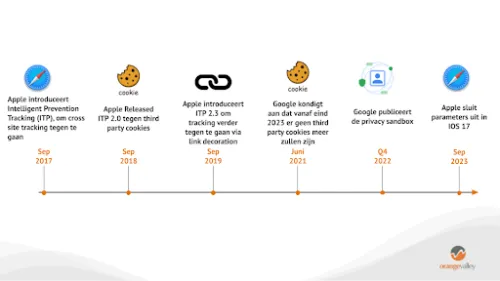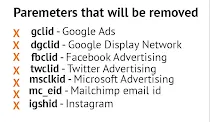Consumers today expect a seamless digital shopping experience across different channels, where both the purchase and the customer experience are essential. Online visitors demand more information, freedom of choice, and autonomy in their decisions. Individual expectations, customer experience, and privacy are gaining significance. Leading tech companies like Facebook, Google, and Microsoft are increasingly emphasizing user interest and privacy, influencing the abolition of third-party cookies and bringing changes to how we drive and measure marketing campaigns. In this article, I will guide you through the impact iOS 17 has on your digital marketing strategy.
Most people have probably noticed that Apple has been more focused on the safety and privacy of its users in recent years. A good example of this is how Apple handles third-party cookies. Through their Intelligent Tracking Prevention (ITP), Apple already blocks many trackers. Think of Facebook, Microsoft, and Google Ads. All third-party cookies that Apple wants its users to use as little as possible. In addition, Google is also constantly working on privacy developments. The following timeline shows the major changes in privacy over the past years.

Even more focus on user privacy with IOS17
The most recent development in Apple's privacy strategy is in the latest iOS update. Within iOS 17, Apple will use various methods to further ensure user privacy. Initially, these changes only apply within the private mode in the Safari browser. However, the expectation is that this will eventually expand to the regular browser.
The logical question, of course, is what is the impact of these adjustments and what can I do to ensure that accurate measurement can continue, to answer those questions it is first important to understand what exactly Apple is doing.
This is what your new UTM parameter will look like!
The biggest change Apple has implemented that mainly affects your marketing tracking is the removal of tracking code parameters from the URL.
The situation will look like this:
Previously: https://www.yourwebsite.com/?utm_medium=adword&GLCID=example
After the update: https://www.yourwebsite.com/?utm_medium=adword
Apple will remove the following parameters:

As a result, it is not possible to track users across multiple channels to drive campaigns in this way. For now, this setting is enabled by default in the private mode of Safari within IOS 17 and in Apple Mail and Apple Messages, but this setting can also be manually enabled for regular use. Additionally, it is expected that the settings will eventually always be enabled by default.
Cross domain tracking more difficult
The removal of URL tracking has direct consequences on the measurement and steering of campaigns. Because the parameters are no longer available in the URLs, it is difficult to track users across multiple channels and it is also harder to see, for example, from which campaigns users originate.
Initially, the impact will be minimal given the fact that the functionality that facilitates this is only available in private mode within iOS 17. This is the latest update from Apple, so it will take some time before all IOS users have switched to it. However, this is a development to keep an eye on for the future as more and more people start using iOS 17. Also, this is just a small step in the direction Apple is ultimately heading with making it as privacy-safe as possible for their users.
Based on historical trends with major labels, it can be seen that compared to various Apple updates from the past, the majority (80-90%) of Apple users will be using IOS 17 by the end of Q1-2024.
5 tips to measure as effectively as possible
There is no specific solution for all the changes Apple is implementing. However, we can provide advice on how you can continue to measure and steer in the evolving world of online privacy while being less dependent on third-party cookies and traditional tracking methods. Good examples of this are:
- Server Side Tagging is an intermediate step where all outgoing data passes through before reaching analytics and third-party tools. This makes the data collected first-party data
- Facebook Conversion API: The way to measure Facebook data via Server Side tagging, allowing this data to run through your own domain and be first-party data.
- Enhanced Conversions: Enhanced Conversions uses data that the customer has filled in themselves (First Party Data) to measure conversions more accurately.
- Consent Mode: a way to continue measuring your events and conversions on the website without cookie consent by means of pings that serve as a reference point for, for example, Google Ads to still attribute a conversion to the right channel. Consent Mode also helps with dynamically triggering tags based on the given consent.
- Apple also has its own solution called Private Click Measurement (PCM). PCM is an in-browser API that supports conversion measurement, aimed at measuring ad effectiveness by looking at clicks and conversions. It protects privacy by limiting information and sending anonymized reports with delays to websites.
PCM is a limited solution because it can still track unique users. PCM also has limited measurement capabilities compared to existing ad measurement methods (see above), particularly due to delays and insufficient identification tools for campaigns. PCM is seen as a compromise between user privacy and ad efficiency, making PCM less effective than the aforementioned solutions.
Future proof marketing: privacy first
To respond to Apple's developments and developments within the entire digital marketing world, the above solutions are very suitable. It is therefore not enough to simply implement these solutions. This also requires a change of mindset for your company. It is necessary to constantly keep the customer journey in mind and perhaps even more importantly, the privacy of users. Thinking privacy first is necessary, with this you are ready for the future and can respond early to upcoming developments as a company.




